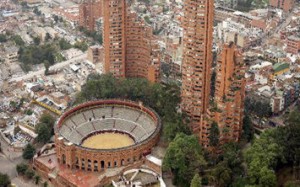Barrera Taurina…rumors, half-truths, and anything in between…

The Plaza Santa Maria de Bogota, Colombia, has been ordered to reopen as soon as possible by a 5 – 4 vote of the Colombian Constitutional Court, thus ruling finally that Bogota Mayor Gustavo Petro’s unilateral 2012 decision to close down the plaza—and by extension any taurine activity in the city—was unconstitutional and beyond the scope of his office.
One of South America’s most important plazas from the 40s through the 90s, the Bogota aficion was forced by Petro, who has stated that he would rather lose an election than see el toreo continue, to find other plazas and other countries, to satisfy its “ganas de toros.” Pressure was brought, initially, by a group of 8 Colombian novilleros, who staged a three-month long hunger strike at the Plaza’s entrance for “their right to free expression” as artists of an accepted cultural practice. The judges cited that right, along with “Ley 916 de 2004”, which explicitly forbids mayors or governors from making demanding any type of extra permission, regulation, or stipulation to inhibit the celebration of corridas. Although the ruling allows taurine activity to resume immediately, the judges stipulated that before any taurine events can take place, the neglected physical structure of the plaza, built in 1931, must be restored for safety concerns. Corridas will most likely resume in the fall of this year.
Luis Sayeg, third partner, along with Pablo Moreno and Juan Pablo Corona, of Casa Toreros, stated that the innovative taurine empresarial group is finalizing plans for the 2015 temporada in Tijuana. Asked to comment on prospects, including specific toreros, Sayeg declined to say which, if any, have been contracted for the season, which was rumored to be at risk. Sayeg stated only that Casa Toreros is currently busy with multiple “Carnaval” fairs in the cities of Jalostotitlan and Autlan de la Grana, Jalisco, as well as Villa de Alvarez, Colima, held in the world’s most unique plaza de toros, a wood and hemp fiber arena constructed by the town’s residents each year specifically for their carnival observances. A press conference in March or early April will detail the number of events as well as some of the participants.
The last corrida of the 2014-2015 temporada in Mexico City will took place last Sunday, February 15. Originally thought to include Spanish master rejoneador (horse bullfighter) Pablo Hermoso de Mendoza, who apparently could not agree to terms with the “management” of the ring, the card instead featured three of the successes (??) of the season, Jose Luis Angelino, Jose Mauricio, and Fermin Rivera. Certainly a worthy, and justifiable, combination crafted as cartels once were; based on the successes in previous corridas. Such in the moment thinking is hardly common in the modern taurine empresariat; more likely are the multiple appearances of the consolidated “figuras”, merited or not, whose box office appeal has been proven, as likely as not sandwiched between safer, veteran matadors who are happy simply to be active again, and younger, inexperienced men whose chances for future employment hinge on these limited appearances.
The season in La Mexico can be divided into two parts; the 1st 2/3, which featured several encierros of bulls of questionable age and almost embarrassingly poor physical presentation, 2 indultos (the pardoning of a bull’s life after a superior (???) performance) and so many dubiously awarded ears that even the normally easygoing capital city taurine press found it necessary to raise an alarm, and the last 1/3, which saw more—not most—legitimately presented bulls, whose bravery, maturity, and trickiness added an element of danger and authenticity sorely missing from the first 60%. Another indulto, to the spirited, demanding casta of “Gibtraltar” of the Queretaro ranch of Xajay served only to underscore the illusory puffery of the first two pardons, to “Sonajero” of Villa Carmela, and “Bomboncito” (wow! If only that name were in the least ironic) of Jose Maria Arturo Huerta. Both animals were nobles—meaning honest and straight charging—perhaps to a fault—with that sheepish sort of robotic, passionless charge so characteristic of the “post-toro Mexicano”.
Of equal worth was the spirited performance of matador Sergio Flores, who, like compatriot and now world class figura Joselito Adame, has consistently demonstrated great gifts but been systematically ignored by empresarios throughout the country, probably because those gifts represent such a threat to the established hierarchy. Kudos to Xajay ganadero Javier Sordo, for daring to present consistenly BRAVE—not easy—bulls, and to Flores, for his determination and unwavering commitment to become a real figura.




